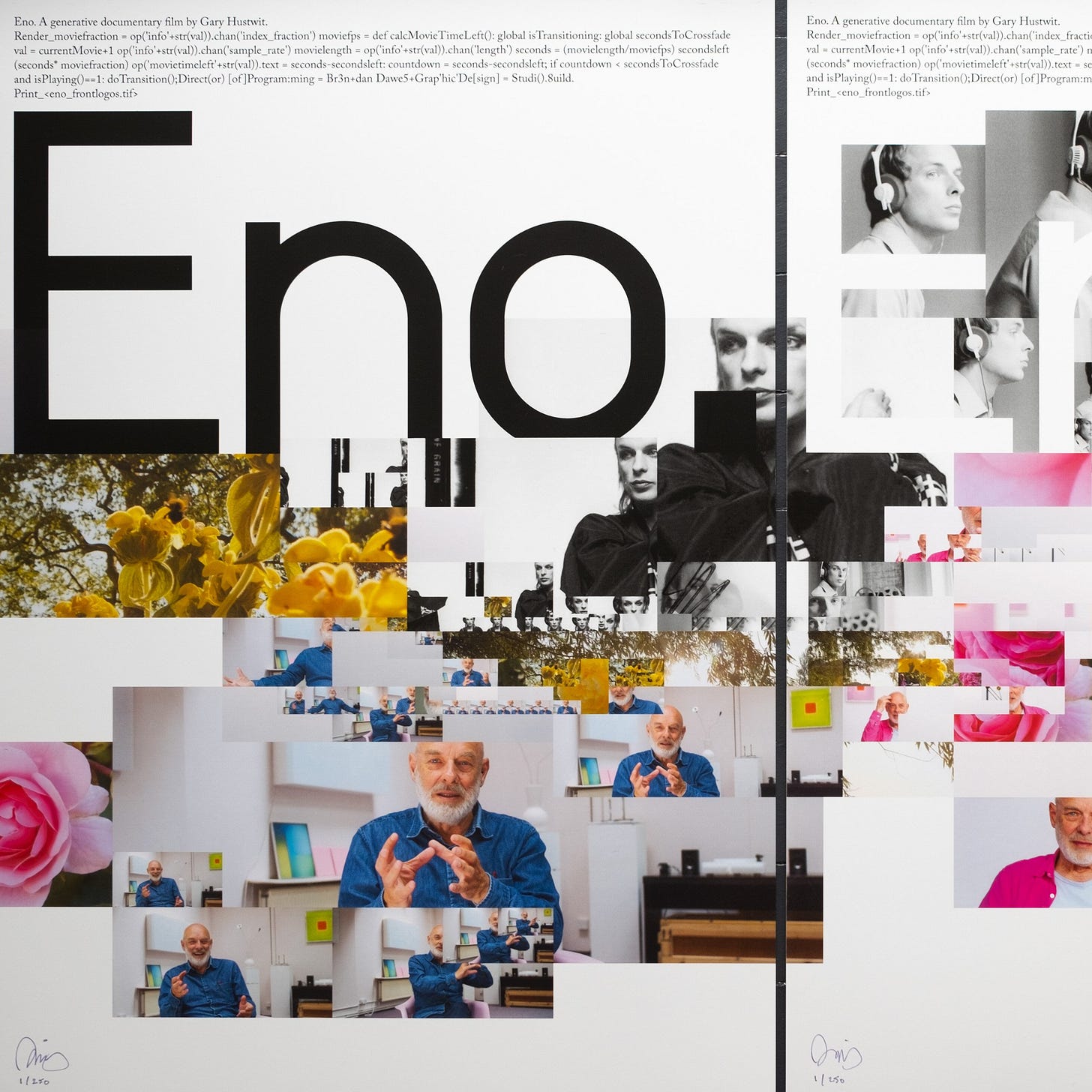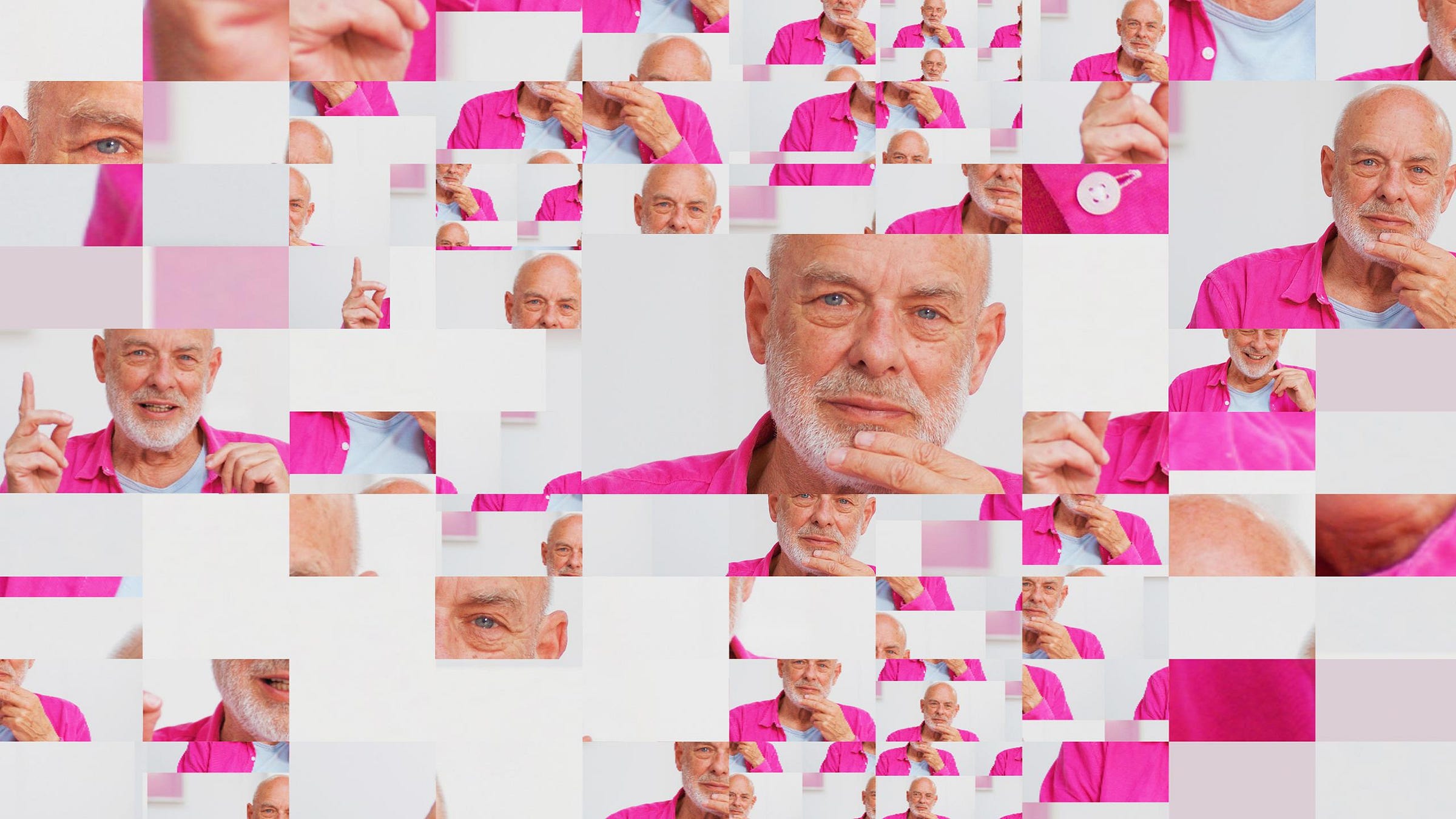Sure, it’s generative, but don’t call it AI
How Brian Eno’s shapeshifting documentary eschews the AI hype
Last weekend, my husband and I caught Eno, Gary Hustwit’s new documentary about Brian Eno, at Angelika East. The 11:00AM Saturday screening felt potent—theater mostly empty, first days of the new year—and spotting our screening date and venue in the opening titles made it feel like a special one-off moment. It was. The film creates a unique 90-minute version of itself every time it plays.
The film employs “bespoke generative software” to sequence scenes and create transitions, blending original and archival interviews with Eno—mirroring its subject’s own creative practice. After a year seeing “AI” wedged into every product’s marketing copy, its absence was striking. Surely bespoke generative software was some sort of euphemism. Or was it?
Five years in the making
In 2019, while Hustwit and creative technologist Brendan Dawes were exploring the idea of making a film that was “never the same twice,” Hustwit had just finished working with Eno on the soundtrack to Rams. The intersection seemed kismet. The musician, famous for dodging traditional bio-docs, was intrigued: What if the film itself could be generative, like his own art?
Since the 1970s, Eno’s been pioneering generative approaches—from early tape loop experiments to landmark ambient works like Music for Airports. His 1996 album Generative Music 1 used software that could “grow” unique musical developments using basic guiding parameters. He even created “Oblique Strategies” cards with artist Peter Schmidt, introducing randomness into the creative process through prompts. (Our* showing had a great clip of him using them with Bowie.)
*In “ooooour” showing / “myyyy” screening—isn’t that fun?
Not all that generates is AI
The custom software developed by Hustwit and Dawes, nicknamed “Brain One” (an anagram of Brian Eno), sequences scenes and creates transitions from roughly 30 hours of interviews and 500 hours of never-before-seen archival footage and unreleased music. But the film’s makers correct journalists who describe this as AI.
“I always say it’s artist’s intelligence, it’s not artificial intelligence,” says Hustwit. “Because we’ve programmed the system, it’s not like we trained it on other people’s films or something. We programmed it with our intelligence to do a very specific thing, which is to make this film but make it different, make it work from an editorial standpoint regardless of what individual footage and scenes get put in.”
The distinction between “generative software” and “generative AI” feels a bit fuzzy, but seems to lie in how AI systems use machine learning to identify patterns in data without explicit programming, whereas Brain One does not. Instead, it selects from pre-edited modules with predetermined transitions and sequences that maintain narrative coherence while allowing for variation. They compare it to gardening (my showing had ample footage of Eno in/around gardens)—cultivating possibilities within thoughtful constraints.
This framing feels particularly relevant given how central AI regulation was to 2023’s SAG-AFTRA and Writers Guild strikes, with both organizations securing landmark protections against AI replacing creative work.

Beyond binary thinking
Both Hustwit and Eno resist simple anti-AI stances, however. In my screening, Eno spoke at length about embracing the technology while cautioning against its accelerating pace. As he told the LA Times: “We should be completely used to the idea of not being in control... Just think about airlines. We completely trust how the system works. We have no idea at all how the systems work.”
His real concern? “If it’s in the hands of Silicon Valley frat boys, I’m seriously troubled... We should not have allowed a situation where those very big decisions, which will affect all of our futures quite a lot, are in the hands of a very small number of completely unelected people.”
A new kind of movie machine
Last year, Hustwit and Dawes launched Anamorph, turning their experiment into a broader platform for generative filmmaking and new approaches to streaming. They collaborated with Teenage Engineering to build a physical “Brain One” machine—a beautiful aluminum box that allows for live control during screenings.
“I’m always thinking about new tools and what capabilities they make possible,” Hustwit tells Lightspeed Ventures Partners’ Michael Mignano with regards to AI. “For me, it’s not about, ‘Oh, I can do this cheaper and quicker now.’ I’m thinking about, ‘What can I dream of now that with this new tool that I couldn’t do before? What does it unlock creatively?’”
I’m thinking about, ‘What can I dream of now that with this new tool that I couldn’t do before? What does it unlock creatively for me as a filmmaker?’
Generation next
For those intrigued by the possibilities, there is a 24-hour livestream on January 24. For $24, you’ll get access to multiple unique versions of the documentary generated around the clock, plus behind-the-scenes content and conversations with the team.
As one of Brian and Peter Schmidt’s Oblique Strategies cards suggests: Honor thy error as a hidden intention. Sometimes the most interesting path forward means rejecting the obvious technical solution in favor of something more thoughtfully constrained.



